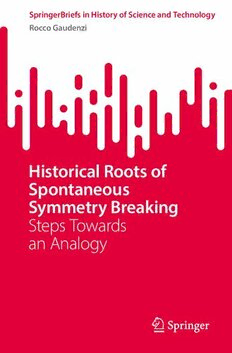
Historical Roots of Spontaneous Symmetry Breaking: Steps Towards an Analogy PDF
Preview Historical Roots of Spontaneous Symmetry Breaking: Steps Towards an Analogy
SpringerBriefs in History of Science and Technology Rocco Gaudenzi Historical Roots of Spontaneous Symmetry Breaking Steps Towards an Analogy SpringerBriefs in History of Science and Technology SeriesEditors GerardAlberts,UniversityofAmsterdam,Amsterdam,TheNetherlands TheodoreArabatzis,UniversityofAthens,Athens,Greece BretislavFriedrich,FritzHaberInstitutderMaxPlanckGesellschaft,Berlin, Germany UlfHashagen,DeutschesMuseum,Munich,Germany DieterHoffmann,Max-Planck-InstitutefortheHistoryofScience,Berlin,Germany SimonMitton,UniversityofCambridge,Cambridge,UK DavidPantalony,Ingenium-Canada’sMuseumsofScienceandInnovation/ UniversityofOttawa,Ottawa,ON,Canada MatteoValleriani,Max-Planck-InstitutefortheHistoryofScience,Berlin, Germany TomArchibald,SimonFraserUniversityBurnaby,Burnaby,Canada TheSpringerBriefsintheHistoryofScienceandTechnologyseriesaddresses,inthe broadestsense,thehistoryofman’sempiricalandtheoreticalunderstandingofNature and Technology, and the processes and people involved in acquiring this under- standing. The series provides a forum for shorter works that escape the traditional bookmodel.SpringerBriefsaretypicallybetween50and125pagesinlength(max. ca.50.000words);betweenthelimitofajournalreviewarticleandaconventional book. Authored by science and technology historians and scientists across physics, chemistry, biology, medicine, mathematics, astronomy, technology and related disciplines,thevolumeswillcomprise: 1.Accountsofthedevelopmentofscientificideasatanypertinentstageinhistory: fromtheearliestobservationsofBabylonianAstronomers,throughtheabstractand practical advances of Classical Antiquity, the scientific revolution of the Age of Reason,tothefast-movingprogressseeninmodernR&D; 2.Biographies,fullorpartial,ofkeythinkersandscienceandtechnologypioneers; 3. Historical documents such as letters, manuscripts, or reports, together with annotationandanalysis; 4.Worksaddressingsocialaspectsofscienceandtechnologyhistory(theroleof institutesandsocieties,theinteractionofscienceandpolitics,historicalandpolitical epistemology); 5.Worksintheemergingfieldofcomputationalhistory. Theseriesisaimedatawideaudienceofacademicscientistsandhistorians,but manyofthevolumeswillalsoappealtogeneralreadersinterestedintheevolution of scientific ideas, in the relation between science and technology, and in the role technologyshapedourworld. Allproposalswillbeconsidered. Moreinformationaboutthisseriesathttps://link.springer.com/bookseries/10085 Rocco Gaudenzi Historical Roots of Spontaneous Symmetry Breaking Steps Towards an Analogy RoccoGaudenzi MPIfortheHistoryofScience Berlin,Germany ISSN 2211-4564 ISSN 2211-4572 (electronic) SpringerBriefsinHistoryofScienceandTechnology ISBN 978-3-030-99894-3 ISBN 978-3-030-99895-0 (eBook) https://doi.org/10.1007/978-3-030-99895-0 ©TheAuthor(s),underexclusivelicensetoSpringerNatureSwitzerlandAG2022 Thisworkissubjecttocopyright.AllrightsaresolelyandexclusivelylicensedbythePublisher,whether thewholeorpartofthematerialisconcerned,specificallytherightsoftranslation,reprinting,reuse ofillustrations,recitation,broadcasting,reproductiononmicrofilmsorinanyotherphysicalway,and transmissionorinformationstorageandretrieval,electronicadaptation,computersoftware,orbysimilar ordissimilarmethodologynowknownorhereafterdeveloped. Theuseofgeneraldescriptivenames,registerednames,trademarks,servicemarks,etc.inthispublication doesnotimply,evenintheabsenceofaspecificstatement,thatsuchnamesareexemptfromtherelevant protectivelawsandregulationsandthereforefreeforgeneraluse. Thepublisher,theauthorsandtheeditorsaresafetoassumethattheadviceandinformationinthisbook arebelievedtobetrueandaccurateatthedateofpublication.Neitherthepublishernortheauthorsor theeditorsgiveawarranty,expressedorimplied,withrespecttothematerialcontainedhereinorforany errorsoromissionsthatmayhavebeenmade.Thepublisherremainsneutralwithregardtojurisdictional claimsinpublishedmapsandinstitutionalaffiliations. ThisSpringerimprintispublishedbytheregisteredcompanySpringerNatureSwitzerlandAG Theregisteredcompanyaddressis:Gewerbestrasse11,6330Cham,Switzerland Preface This work stems from my fascination for the question of what contributes to a complexdiscoveryandattemptstoproducea“cutaway”,acoresampling,asitwere, of that complexity by way of a conceptual genealogy. Ideally, such a genealogy is a reconstruction of the cultural, material, and cognitive factors that played into the discovery and made it possible. At bottom, it offers a picture of the problems faced by the historical actors, the knowledge resources available to them, and the thinkingprocessesmobilisedtoaddressthoseproblems;anditdoesthatbymeans ofananalysisoftheselectedactors’publishedandunpublishedsources.Theknowl- edgeresourcesareconcepts,theoreticaltechniques,andexperimentalfindings.The thinking processes are here meant as all that explicates in the heuristic strategies adoptedwhenapproachingorrespondingtospecificproblems—bethemthecentral underlyingproblemsorthesecondaryandminorones.Inthepresentstory,essential elementsofthesestrategiesaremathematicalreformulationsandgeneralisations,as wellasconceptualtranspositionsandanalogiesbetweendistinctrealmsofphysical reality. Themostobviouspurposeofourgenealogyofspontaneoussymmetrybreakingis toprovideahistoricalreconstructionwhichhighlightsthedistinctiveaspectsofthis discoveryprocess.Onesuchaspectishowseeminglydistinct(andeven“divergent” inthesensethatwillbespecified)branchesofknowledgeandculturalbackgrounds couldbemutuallyfruitfulandcometoanaprioriunexpectedconfluence.Thisdiving intotheturbulentwatersofprehistory—andtakingthetrouble,besidesthepleasure, todoso—however,alsohasthepurposeofreturningtothesurfacewithaportrait of the logic of scientific discovery (or better, the logic of the discoverer); and in particular,theplacethatanalogicalreasoninghasinsuchalogic.Twoofthe“whys” ofthisengagementwiththeheuristicprocessesaretolearnasmuchaspossibleabout whatwecoulddesignateastheprospectivelogicofthediscoverer,andtounderstand itsdurative,accretingdimension.Asourstoryhereshows,theheuristicworkoften doesnotproceedbyjudgingthetruthorfalsityateachstep,buttakesplaceonalevel where that dichotomy is suspended, and the end justifies the means, as it were. In contrasttothe“contextofjustification”,inthe“contextofdiscovery”thereasoning proceedsonlypartiallyunderthepressureandconstraintoflogicalinference. v vi Preface In the intellectual journey to spontaneous symmetry breaking, this aspect is reflected in the way the leading historical actor, Yoichiro Nambu, employs the analogy.There,analogicalreasoningwasnotatooloflogicalinference,butameans to provide different representations, or redescriptions, of the target object that he waseachtimeinterestedtoknoworformalisebyidentifyingitwithasourceobject that was recognised as similar in a few respects, while being dissimilar in all the others. The epistemic gain stemming from such identification came from the fact that the “structure” (a property, an attribute, a relation between parts, etc.) of the sourcedomainwasalreadyknown,ormoreevidentthanitwasinthetargetdomain. As we will see, in the present case, the quantum vacuum—in the concrete repre- sentationthatPaulDirachadgivenit—wasusedbyNambuasamastersourcefor theformalisationofnuclearmedia,theplasma,andthenthesuperconductor,andin turn,thelattertwobecame,atalaterstage,thesourceobjectsfortheredescription of a more complex quantum vacuum. As happens with any act of representation, these redescriptions were not judged as true or false, strictly physical or unphys- ical,butasappropriatetofaithfullyrenderagivenaspectofthetargetobject.This appropriateness lay in how much a given redescription at a given moment made visibleandinstructedthediscovereronhowtoformulateahypothesis,andinhow muchitextractedandmadevisiblewhatofthetargetobjecthadremainedhitherto hidden or implicit. The reconstruction of these processes and heuristic strategies hopefullyconveystheprovisionalandprospectivelogic—asopposedtoastableand “retrospective”one—ofonewhoisgrapplingwithsomethingyettobediscovered. Thefact,mentionedabove,thatinthisintellectualjourneymany-bodysystemsand thevacuumofparticlephysics,enrichedateachstep,alternatelyplayedtheroleof target and source domain embodies what we refer to as the durative and accreting dimensionofthisdiscovery.Inthissense,ratherthanbeingtheresultofaone-shot solution,thediscoverywasaprocesscharacterisedbyanaccumulationofexperience andexaptationofanumberoftheoreticaltools. Thefacts,concepts,andrelationswhichinfluenceandentermoreorlessdirectly into the discovery of spontaneous symmetry breaking are several and, at times, demand from the reader some commitment by virtue of their technical character. Considering this, we have constructed the present treatment with various reader- ships in mind. Ideally, we wrote it so that readings at multiple levels are possible and, we hope, enjoyable for both the scholarly and non-specialist audience. The advicewegivetothereaderunacquaintedwiththesubjectistotreatthetechnical details like they would treat, in a novel, those detailed descriptions of people and situationswhicharemeanttotransmitanatmosphereratherthanthedetailsthem- selves.Evenifthedetailsofsomenotions,theirdevelopment,andrelationstoothers may remain obscure to some readers, we have made the best efforts to formulate themsothatonecancapturetheirgist,andleavethereadingwithanimpressionof theconceptualflowinscienceandacutawayofthediscoveryprocess.Theintention of offering various possible readings implied a constant negotiation, and an effort to use the minimum possible of mathematics, to be self-contained, to leave out as muchaspossibleunnecessarytechnicalities(orconfinethemtothefootnotes)while preservingthecoreoftheconceptsandaimsthatsetthewheelsofhistoryinmotion. The reader will ultimately judge whether we have managed to do that with some Preface vii successandwhethertheeffortwasworthwhile.Asaclarificationdueforthereader whoispuzzledbyouruseofpersonalpronouns,althoughitisobviousthatliterally speaking“we”usedthroughoutisan“I”,theintentionoftheauthorisnottoascribe an immodest pluralis maiestatis to himself, but, quite the contrary, to transmit the convictionthatanyintellectualeffortisultimatelycollectiveinvariousdegrees. Amongtheclosestpeopleofthis“collective”,IwishtothankAlexanderBlumfor havingencouragedtheideasbehindtheproject,groundedsomeofmyfancies,and ingeneralforthesupportgiventhroughoutthedevelopmentofthiswork.Without hishelpandcompetentadvice,theleveloftechnicaldepth,refinement,andcogency ofsomeofthecentralstepsinthedevelopmentofspontaneoussymmetrybreaking would hardly have been achieved. I am also grateful to my friend and partner in discussions,StefanoFurlan,whosementalworld,brimmingwiththoughtsandorig- inalconnections,hasactedasasourceofinspirationandintellectualstimulus.Among theothermembersoftheresearchgroup“HistoricalEpistemologyoftheFinalTheory Program”attheMaxPlanckInstitutefortheHistoryofScience,IthankNúriaMunõz Garganté, James Fraser, Sebastien Rivat, Giulia Carini, Pablo Ruiz de Olano, and AdriendeSutter fortheir presence as friendsand discussionpartners.The discus- sionswereveryhelpfulandinstrumentalintheunfoldingofmythoughts,aswere thediscussionswithsomeoftheguestsoftheresearchgroup.AthanksgotoRyn Delgadoforthegreathelpwiththeproofreadingofthemanuscript.Iwouldalsolike tothankProf.GiovanniJona-Lasinioforhavingsharedpreciousinformationonthe pathofdiscoverydiscussedhere;andProfs.HajimeInaba,HiroshiEzawa,Daisuke Konagaya, and Dr. Hiroto Kono for having shared their knowledge of science in Japan,aswellastheirwillingnesstohelpwiththetranslationsfromJapanese.The Library Team of the Max Planck Institute for the History of Science has been of utterlyinvaluablesupport.Theirpatienceandkindness,togetherwiththeirefficiency and precision, deserves to be acknowledged. I can say the same about the team of theUniversityofChicagoLibrary,UniversityofIllinoisArchives,andInstitutefor AdvancedStudies. ApartofthisworkhasbeencarriedoutundertheauspicesoftheNWORubicon Fellowshipproject(“Thegenesisofconceptsinmesoscopicphysicsandtheirrole in the reductionist search for a unified theory”), which I was generously granted bytheDutchScienceFoundation(NWO).Consideringthatmyformaltrainingand career prior to this work had been in physics, both the Dutch Science Foundation andtheMaxPlanckInstitutefortheHistoryofScienceactedformeasabridgeto anewcareerandperspectiveonthesciences,enabledmetoconstructabackground inthehistory&philosophyofscienceand,onapersonallevel,allowedmetofulfil my long-standing desire to do research on the conceptual dynamics and historical epistemologicaldimensionofscience.TheMaxPlanckInstitutefortheHistoryof Scienceasasupportinginstitutionandplatformofknowledgeexchangedeservesa specialmention.TheculturalenvironmentattheInstituteanditssingularblendof viii Preface expertisehavebeentheyeastofthistransitionandprofessionalandhumangrowth process. Berlin,Germany RoccoGaudenzi Contents 1 IntroductionandaFewWordsontheMethodology ............... 1 References ..................................................... 8 2 TraitsofanEmergingTradition:ModernPhysicsinJapan ......... 11 2.1 Tomonaga’sApproachtotheOpenQuestionsofParticle Physics ................................................... 12 2.1.1 AtHeisenberg’sandtheRenewedInterestinNuclear MesonHypothesis ................................... 14 2.1.2 ACreativeApplicationoftheHartreeMethod ............ 16 2.1.3 The Tomonaga-Nishina Seminars and the Development of Quantum Field Theory ............................................. 18 2.1.4 The Elementary Particle in the Aftermath ofRenormalisation ................................... 26 2.2 TheCollectiveDescriptionofMany-bodySystems .............. 32 2.2.1 AChangeofParadigmintheDescriptionofNuclei andPlasmas ......................................... 34 2.2.2 Bohm and the Many-body Problem in Plasmas and Metals: Inspirations from Quantum Electrodynamics ..................................... 38 References ..................................................... 42 3 Yoichiro Nambu and the Collective Description ofMany-particleSystems ....................................... 47 3.1 LehrjahreandInclinationsoftheYoungNambu ................ 47 3.1.1 Nambu’s Nuclear Program and the Root ofSpontaneousSymmetryBreaking .................... 51 3.2 TheConceptofApparentVacuum:ExtendingFieldTheory toRealMedia .............................................. 54 3.2.1 NuclearMatterasa“di-mesic”Medium ................. 56 3.2.2 NuclearMatterasaPlasmaMedium .................... 59 References ..................................................... 66 ix
